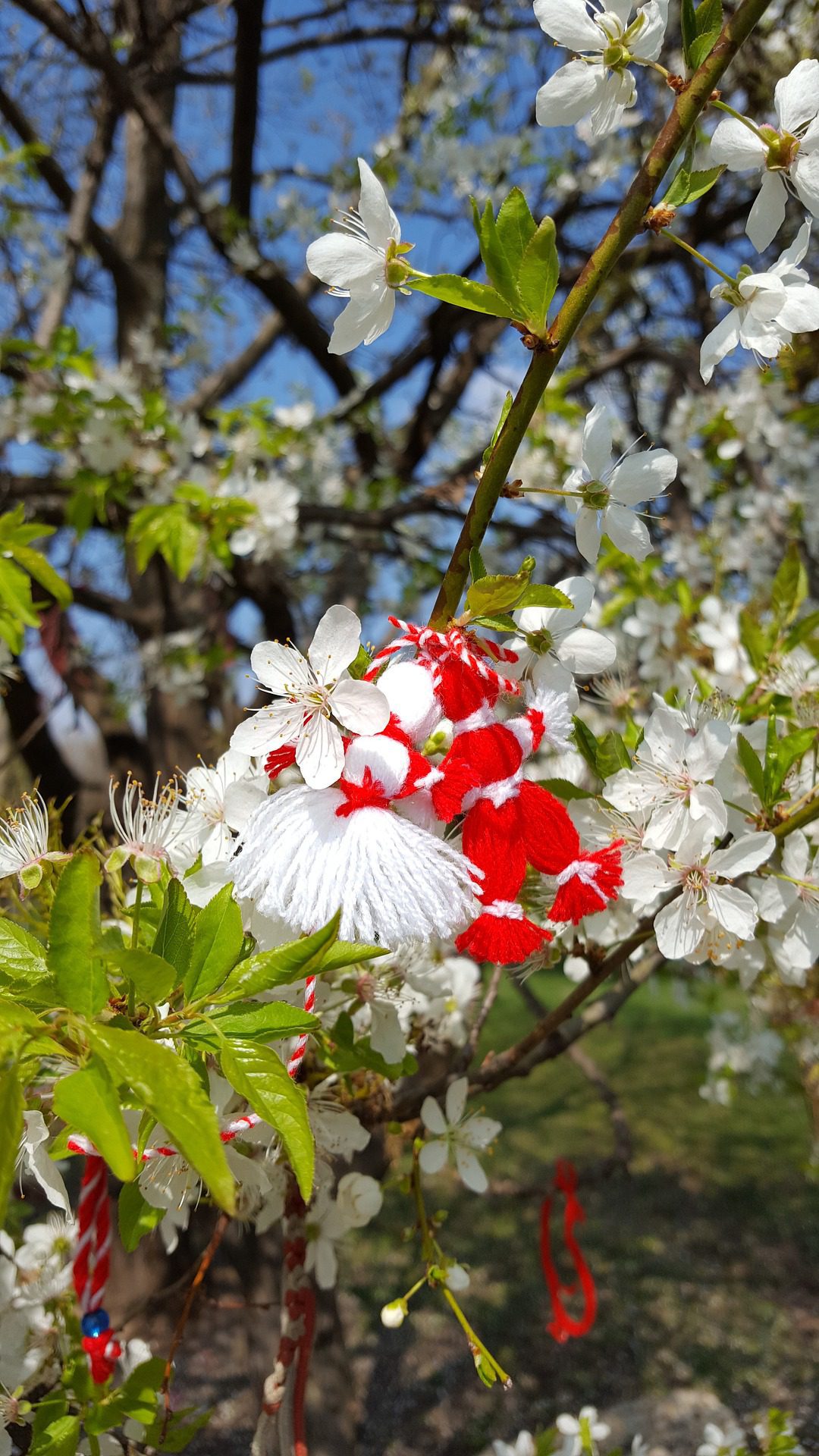Visit BG Crafts Gallery and discover artworks by contemporary Bulgarian artists!
Every year on March 1st, Bulgarian people celebrate a centuries-old tradition called the day of Baba Marta (baba means ‘Grandma’ and Marta means ‘March’), related to sending off the winter and welcoming the approaching spring.
Wearing and giving martenitski
On that day and a few days afterward, Bulgarians exchange and wear the so-called “Martenitski” – decorative pieces of red and white twisted threads, symbolizing health and happiness and a lucky charm against evil spirits. The Martenitsas are given away to friends, family, and colleagues and are worn around the wrist or on clothes. In some villages in the mountains, people decorate their houses and domestic animals.
Martenitsa is made of twined red and white threads – woolen, silk, or cotton. The most typical Martenitsa represents two tiny dolls, known as Pizho and Penda. Pizho is the male doll, usually in white color. Penda is the female doll, usually in red color and distinguished by her skirt.
Martenitsi come in various shapes and sizes: bracelets, necklaces, tassels, pompoms, and balls. The white is a symbol of purity, innocence, beauty, and joy. The red is associated with health, vitality, fertility and bravery.
According to tradition, people wear Martenitsi for a certain period, the end of which is usually associated with the first signs of spring – seeing a stork or a fruit tree in blossom. After that people can tie them to a blossoming tree for fertility thus giving the tree health and luck, which the person wearing the Martenitsa enjoyed while wearing it.
Baba Marta in Bulgarian folklore
In Bulgarian folklore, Baba Marta is a mythical figure who brings with her the end of the cold winter and the beginning of spring. Baba Marta is believed to be a grumpy old woman whose moods swing very quickly and it reflects in the changeable March weather. The belief was that when she was smiling, the weather was sunny and warm, but if she got angry, the cold would stay longer. By wearing the red and white colors of the Martenitsa, our predecessors asked Baba Marta for mercy. They hoped that it would make winter pass faster and bring spring.
Both young and old take care of Baba Marta's good mood. According to tradition, the young got up early before everyone else, to welcome the first day of March and please Baba Marta with their youth, and beauty. Old women wove twisted threads of red and white threads to decorate the house, protect the household from diseases and evil forces. Housewives hung red aprons, sashes, rugs or twisted threads in front of their houses in the hope that when Baba Marta saw them, she would laugh and the sun would rise again.

Martenitsi as cultural heritage
In 2017, the nomination of the Martenitsa element related to the cultural practices on March 1st was registered in the UNESCO Representative List of the Intangible Cultural Heritage of Humanity. That was a multinational nomination of Bulgaria, Romania, Moldova, and the Republic of North Macedonia. That act was the international recognition of the cultural practices associated with 1 March and the martenitsa as a leading ritual element.
In the Bulgarian mindset, martenitsi are seen as one of the national identity tokens. Notwithstanding the fact that most elements of March 1st ritual complex in the folklore calendar have dropped out, it still is a sustainable tradition today for all members of the Bulgarian community to wear martenitsi.
In the 19th-century folklore tradition, martenitsi were neither given as a present nor exchanged. They were usually made by the oldest woman at home; she tied a red-and-white twisted thread around the wrist or the neck of the most vulnerable family members: children, maidens, and young brides as well as newborn domestic animals.
In modern times, festive practices were urbanized, and new cultural models appeared. The martenitsa changed its functions; so did the shape and the materials of which it was made. It became a commodity produced by craftsmen and specialized industrial company departments. A new form of greeting exchange appeared: good wishes sent on illustrated postcards with martenitsas attached to them. That practice started in the early 20th century and became widespread after the 1960s. Although mostly virtual, today we keep sending and receiving Baba Marta postcards.
New phenomena triggered by the new technologies appeared: virtual greetings replace the common postcards; moreover, a huge amount of information about the “new old” mythology of the martenitsa, and the ritualism for March 1st is getting spread on the internet. However, the focus is generally on the semantics and the pragmatism the Bulgarians attribute today to the martenitsi. Martenitsi are a valuable indicator of the community development processes, priorities, and trends.
Where are the martenitsi? Are they in museums?
The fundament of any museum is its collections. Their richness, diversity, and level of understanding of what they represent largely predetermine the performance of the museum’s key goals, namely to preserve, study, promote, show and share knowledge. The search for materials on this topic in the museums has revealed that only the British museum holds a collection of Bulgarian martenitsi that is digitalized and virtually accessible. Most of them are from the 1990s. The British professionals have qualified them as cultural heritage defined as ‘amulets’ connected with Bulgaria. The situation in the Bulgarian museums is rather different. Most of them do not have in their main funds martenitsi registered in the inventory lists. The martenitsi in the museums in the country are replicas of traditional originals; they are made by museum professionals on the basis of field work descriptions in order to have illustrations of ritualistic objects in an exhibition narrative about calendar practices; some of them are common designs made by representatives of communities that are being studied and presented. The only digitalized collection in Bulgaria is in Museum Russe. Thanks to ethnologist Iskra Todorova, the museum collection is available to all visitors.
Martenitsa as a work of art
The popular practice of reviving ancient and traditional crafts in contemporary art is nothing new; age-old techniques have become ubiquitous across the art market and in museums and galleries alike. The reemergence of such methods has been described as a gesture towards something more certain and tangible in a troubled time, or a means of rejecting the digital in favor of the handmade. Crafts represent a genuine intersection that resonates with the present moment.
Contemporary Bulgarian crafts artists are still designing martenitsas with traditional materials – wool, cotton and beads. Some of them are preparing martenitsas as wall accessories for living room, other are specialized in preparing traditional martenitsas as pieces of jewelry. They often works collaboratively with artists from different country regions, to create works inspired by traditional designs and introduce surprising and unexpected interpretations of martenitsi.
Find unique and affordable art and traditional martenitsi, and follow us for more information: BG Crafts Gallery
References:
Todorova, Iskra 2020. March 1st festivity during socialism.
Todorova, Iskra 2021. The Martenites in museum interpretations.

